An exploration into the influential roles of chief priests in the Bible, revealing their impact on history and spirituality.
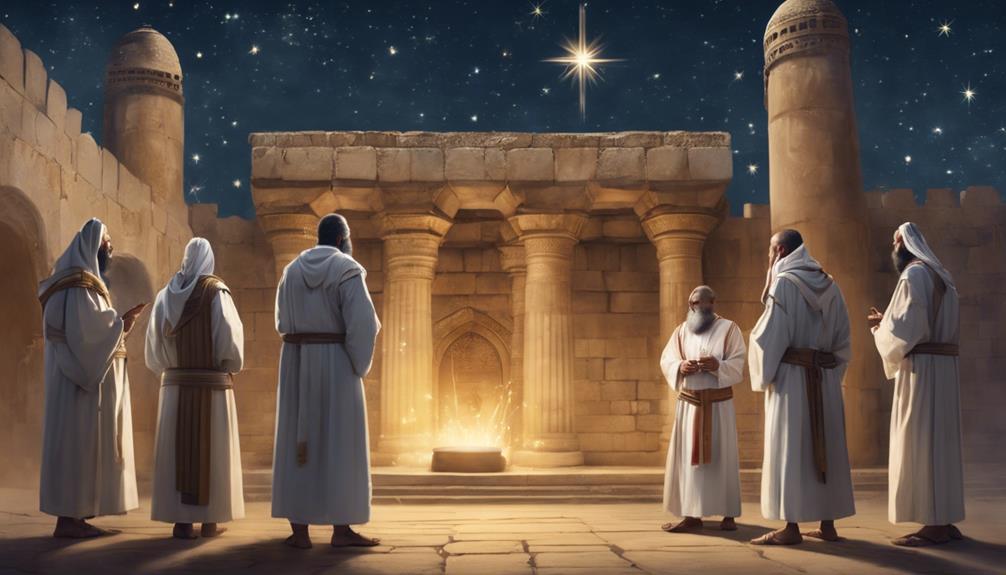
Chief Priests in the Bible
You might not have considered the pivotal role that chief priests play in the narrative arc of the Bible, serving not just as religious figures but as influential leaders in their communities.
From Aaron, the first high priest, to Caiaphas, during the time of Jesus, these individuals' decisions and actions significantly impacted the spiritual and social dynamics of their times.
As you explore their stories, you'll uncover how their leadership influenced both the course of biblical events and the development of religious practices.
This journey will offer a deeper understanding of their complex roles and the lasting legacy they left behind.
Key Takeaways
- Chief priests played pivotal roles in spiritual, judicial, and political matters in biblical times.
- Their duties included offering sacrifices, maintaining the Tabernacle, and teaching God's laws.
- The legacy of chief priests is a mix of devout leadership, familial challenges, and moral guidance.
- During Jesus' ministry, the high priest Caiaphas exemplified the complex balance between religious authority and political maneuvering.
Aaron: The First High Priest
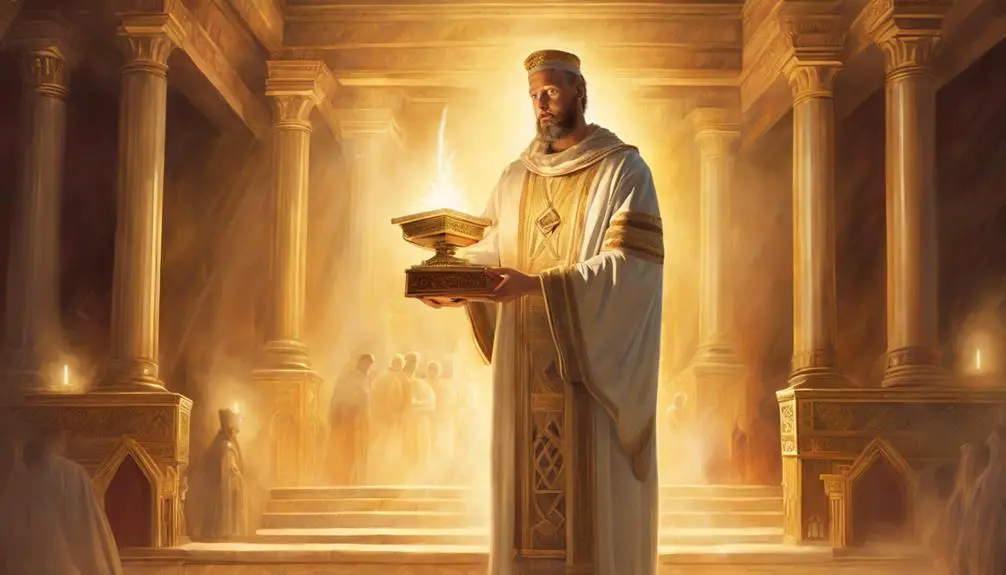
Aaron, the older brother of Moses, holds the distinction of being the inaugural high priest in Israelite tradition, setting a precedent for religious leadership. His role wasn't merely ceremonial; it was foundational in establishing the Levitical priesthood, which became central to Israelite religious practices. You'll find that Aaron's responsibilities were vast, encompassing both the spiritual and the practical aspects of worship.
Diving deeper, you notice that Aaron's attire, the Levitical garments, weren't just clothing but symbols of his sacred duties. These garments, described in detail in the Torah, were designed to set him apart from the rest of the congregation, underscoring his unique role in mediating between the people and God. The ephod, breastplate, and the Urim and Thummim were integral parts of these garments, each serving a specific purpose in the rituals Aaron performed.
Moreover, Aaron's sacred duties extended beyond the aesthetic. He was tasked with making sacrifices, maintaining the Tabernacle, and teaching the Israelites the laws God had given them. His role was pivotal in guiding the moral and spiritual direction of his people, shaping the priesthood that would follow for generations.
Eli and His Legacy
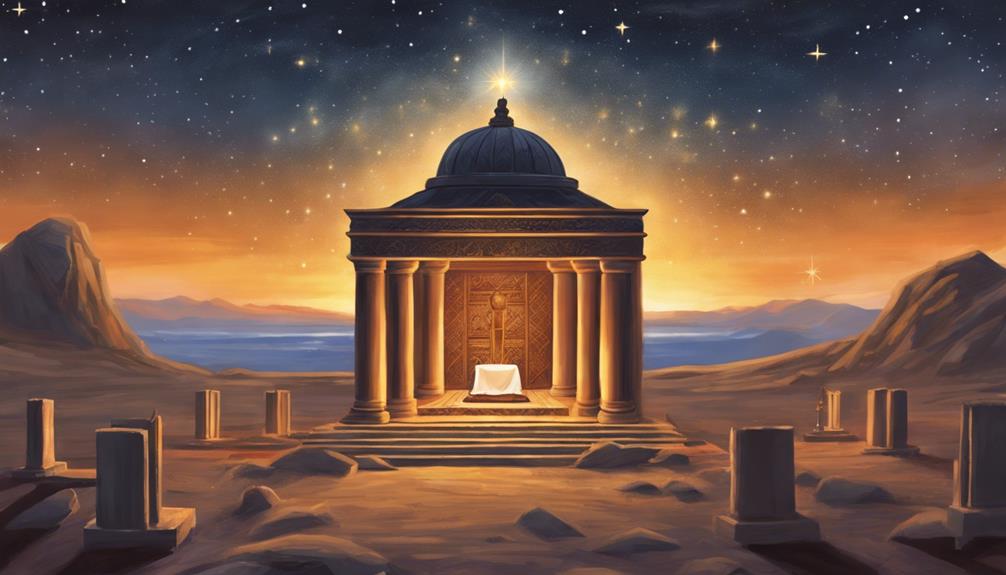
Transitioning from the era of Aaron, Eli's tenure as high priest marks a critical juncture in the history of Israelite religious leadership, illustrating both continuity and deviation within the priestly tradition. Eli's period in office is characterized by a mix of devout leadership and personal tragedy, notably through his sons' corruption, which ultimately leads to his downfall.
You'll see that Eli's dedication to serving as high priest is evident in the biblical narrative, yet it's overshadowed by his sons' actions. Their corruption not only dishonors the sanctity of their office but also directly challenges the ethical and religious standards expected of Israel's priesthood. This divergence from the established priestly conduct underscores a significant deviation from the tradition set forth by Aaron and his descendants.
Moreover, the narrative of Eli's downfall is intricately linked to the misconduct of his sons, highlighting a crucial theme in biblical stories: the impact of personal failings on communal leadership and destiny. The consequences of their actions serve as a stark reminder of the responsibilities that come with religious leadership and the potential repercussions when these are neglected.
Eli's legacy, therefore, is a complex blend of personal piety and familial failure, offering critical insights into the challenges and expectations faced by Israel's religious leaders.
Samuel: Prophet and Priest
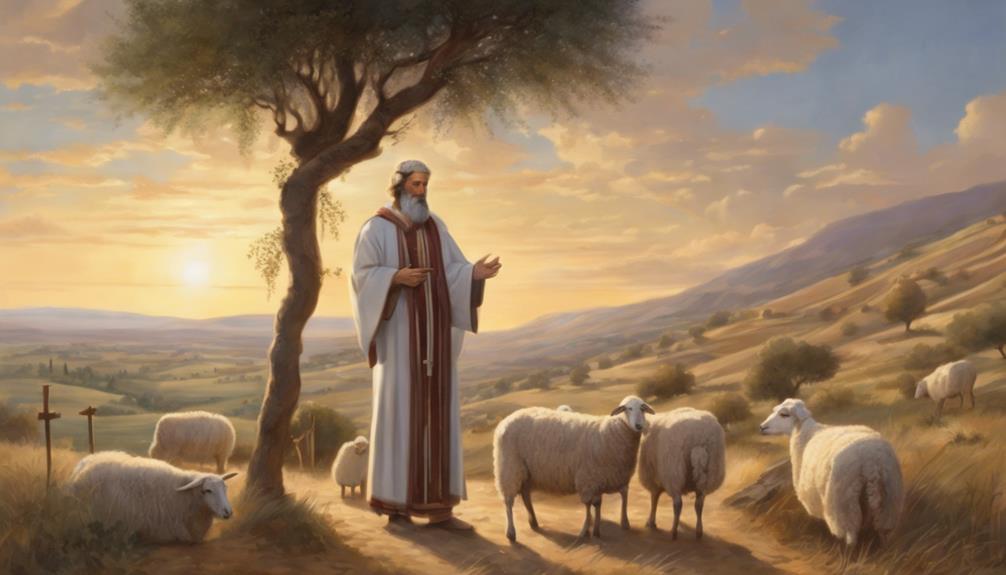
Following Eli's complex legacy, we encounter Samuel, whose unique role as both prophet and priest sets him apart in Israel's religious and historical landscape. Samuel's journey isn't just a narrative of religious significance but also a pivotal moment that transitions Israel from the era of judges to the establishment of a monarchy.
Here are four key aspects of Samuel's contribution:
- Samuel's Mentorship: Under Eli's guidance, Samuel's early introduction to religious service prepared him for his dual roles. Despite Eli's own shortcomings, Samuel emerged with a strong moral compass and a dedication to God's work.
- Prophetic Roles: Samuel's prophetic roles were multifaceted, involving not only foretelling but also forth-telling, where he addressed the moral and spiritual decline of Israel.
- Priestly Duties: As a priest, Samuel led by example, offering sacrifices and teaching the people about God's laws and commandments.
- Judge and Leader: Beyond his spiritual duties, Samuel also acted as a judge and leader, guiding Israel through its transition to monarchy while ensuring the people remained faithful to God.
Samuel's life bridges the gap between two significant eras in Israel's history, making his contributions both unique and indispensable.
Zadok: Loyal to David
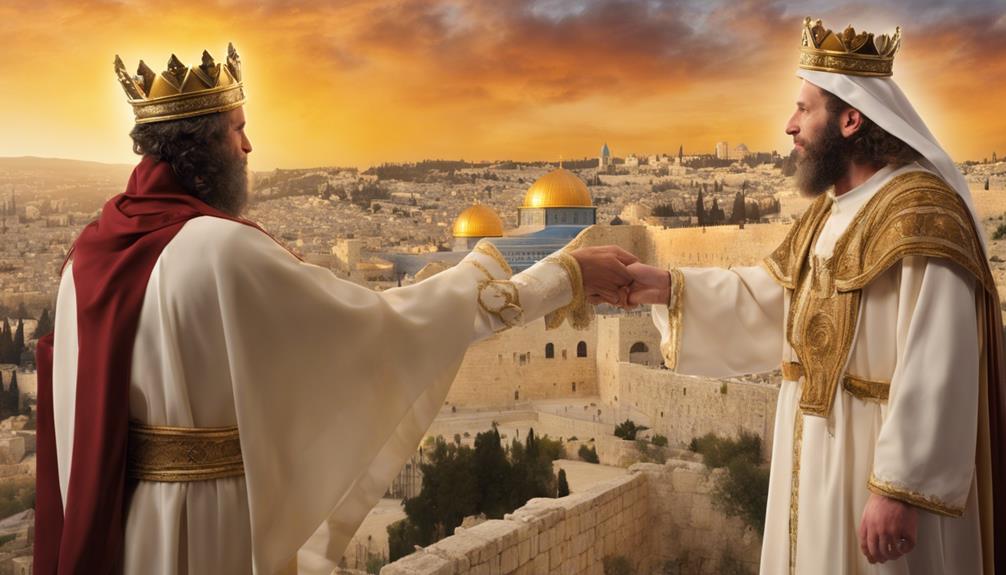
Loyalty emerges as a defining characteristic of Zadok's priesthood, particularly in his unwavering support for King David during some of the most tumultuous periods of David's reign. You'll find that his allegiance wasn't just about political savvy; it was deeply rooted in a belief in David's divine right to rule. This loyalty wasn't misplaced. When Solomon, David's son, ascended to the throne, Zadok's position as a chief priest was solidified, linking his fate to the establishment of Solomon's temple, a symbol of national unity and divine presence.
Aspect |
Details |
|---|---|
Zadok's Lineage |
Descendant of Eleazar, Aaron's son. |
Role Under David |
Served as a priest and advisor during David's reign. |
Contribution to Solomon's Temple |
Played a pivotal role in its religious ceremonies. |
Zadok's lineage, tracing back to Aaron through Eleazar, positions him within a prestigious priestly line, reinforcing his authority and legitimacy. His contributions, especially during the foundation of Solomon's temple, underscore the significant role he played in shaping the spiritual landscape of Israel, marking him as a key figure in biblical history whose loyalty and dedication were instrumental in the consolidation of Davidic rule and the establishment of a central place of worship.
Caiaphas: In the Time of Jesus
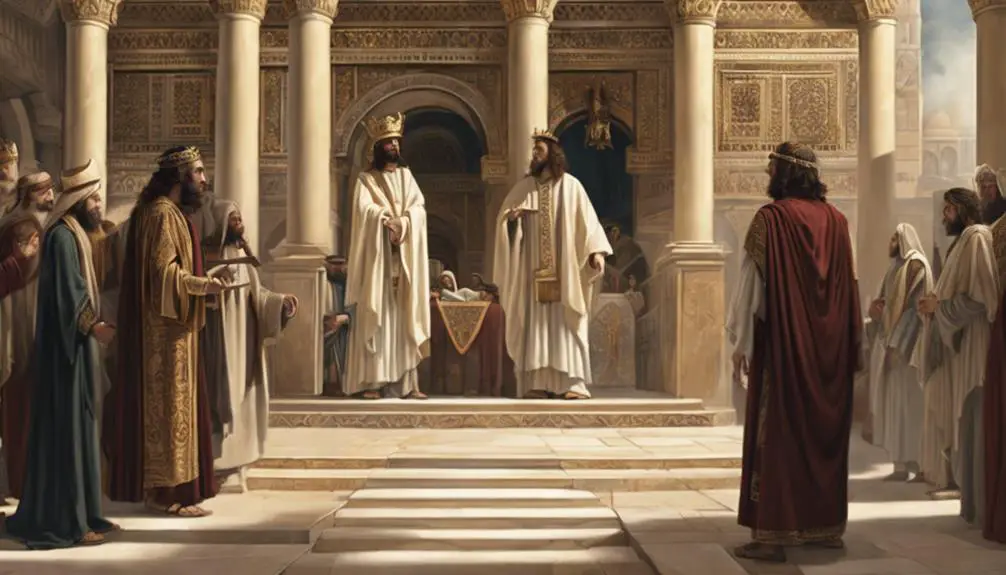
Caiaphas, the high priest during Jesus' ministry, played a crucial role in the events leading up to the crucifixion. His trial role and actions in the religious and political spheres of the time spotlight his significant influence. You'll find that understanding Caiaphas helps in grasping the complex dynamics at play during one of history's pivotal moments.
Here are key aspects of Caiaphas' impact:
- Trial Role: Caiaphas presided over Jesus' trial before the Sanhedrin, highlighting his central role in the legal proceedings that led to Jesus' death sentence.
- Political Acumen: His ability to navigate the delicate balance between Roman authority and Jewish autonomy demonstrates his political savvy and his influence in maintaining order.
- Priestly Vestments: As high priest, Caiaphas wore distinct priestly vestments that symbolized his authority and sacred duties. These garments underscored his role in the religious hierarchy and his direct involvement in spiritual matters.
- Legacy: The decisions and actions taken by Caiaphas during Jesus' trial have been analyzed throughout history, reflecting on the interplay between religious authority and moral judgment.
In dissecting Caiaphas' role, you encounter a figure deeply entwined with the theological and cultural fabric of his time.
Frequently Asked Questions
How Did the Role of Chief Priests Evolve Throughout Different Periods of Biblical History?
You're exploring how a specific leadership role changed over time, focusing on shifts in responsibilities and symbolism. Initially, those roles were deeply tied to priestly garments and the Aaronic lineage, indicating a sacred status and direct descent.
As periods shifted, their duties and the perception of their authority evolved, reflecting broader societal and religious transformations. This evolution underscores the dynamic nature of leadership and its adaptation to changing cultural and spiritual landscapes.
What Were the Daily Responsibilities and Duties of a Chief Priest Outside of Temple Sacrifices?
When looking at high-ranking religious figures, their daily duties extended beyond ceremonial roles. You'd find them donning priestly garments not just for show but as a symbol of their sacred office.
They were deeply involved in community leadership, guiding the moral and spiritual direction of their people. This role required them to be advisors, educators, and judges, ensuring the community's adherence to religious laws and traditions.
How Did the Selection Process for Chief Priests Change After the Babylonian Exile?
After the Babylonian exile, the selection process for chief priests underwent significant changes under Zerubbabel's leadership, influenced heavily by Persian policies.
You'll find that these reforms reshaped the religious hierarchy, aiming to align more closely with the Persian empire's administrative strategies.
This period saw a shift towards a more structured and possibly politicized selection process, diverging from earlier traditions to ensure the religious leadership remained aligned with the prevailing political powers.
In What Ways Did Chief Priests Interact With and Influence Political Leaders and Kings in the Bible?
In the texts you're exploring, chief priests often interacted with political leaders and kings through religious manipulation and political alliances. They'd leverage their spiritual authority to influence decisions, shaping political landscapes to their favor.
These alliances were strategic, ensuring their positions remained influential. This manipulation wasn't just about power; it was a calculated move to maintain their religious and societal roles, affecting governance and the direction of their communities.
What Were the Major Controversies or Criticisms Faced by Chief Priests According to Biblical Accounts and Historical Interpretations?
You're diving into issues like priestly corruption and sacrificial debates, which stirred major controversies. These problems weren't just gossip; they were deeply rooted in ethical and religious practices.
Critics argue this corruption skewed the spiritual integrity of the roles, while debates on sacrifices questioned the very traditions upheld.
Analyzing these issues, you'll find they're not just historical footnotes but pivotal in understanding shifts in religious and ethical standards over time.
Conclusion
In analyzing the roles of chief priests in the Bible, it's clear they were pivotal in shaping Israel's spiritual and social landscape. From Aaron's foundational priesthood to Caiaphas' controversial tenure during Jesus' time, each priest played a unique role.
Their decisions and actions not only affected religious practices but also had profound political implications. Understanding these figures helps in comprehending the complex interplay between faith, power, and leadership in biblical history, highlighting their enduring influence on religious traditions.

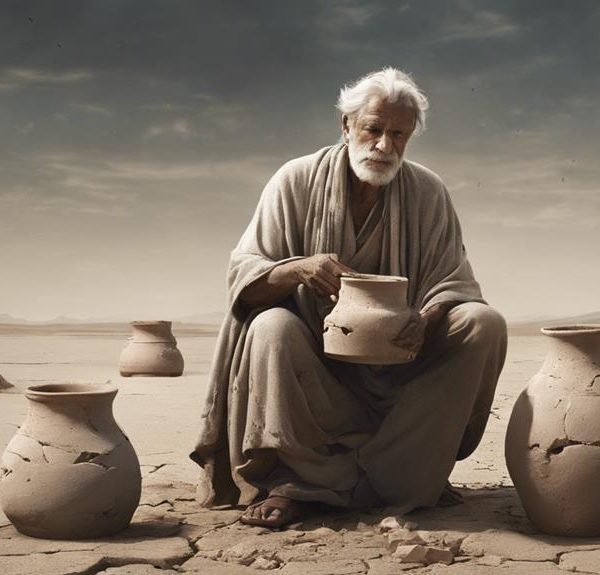

Sign up